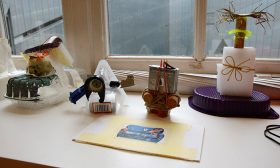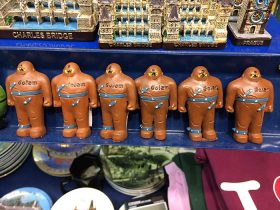
Golems made in our Golem Atelier; Jewish Museum Berlin, photo: Svenja Kutscher
Hebrew newspapers and colorful cloth remnants are lying on the floor. On the table there are wires, chains, old electrical equipment, cooking pots, used eyeglasses cases, and buttons, just to name a few of the household items spread around. Everything that would otherwise be thrown away gains a whole new meaning at the Golem Atelier.
Aside from everyday objects there are also a lot of natural materials, such as chestnuts, straw, dried leaves, and pine cones, whose scent reminds me of walks in the woods. → continue reading
Our GOLEM exhibition artists tell us what the mystical creature means to them
How did you first encounter the golem? What does the golem mean to you?
We asked some of the artists whose works are shown in our current exhibition (more about the exhibition on our website) these two questions. → continue reading

Souvenir shop in Prague, 2016; photo: Katharina Schmidt-Narischkin
They’re ubiquitous in Prague souvenir shops: clunky, mechanical golem figurines that owe their popularity to the 1951 film The Emperor and the Golem. The Czechoslovakian comedy classic, called Císařův pekař a pekařův císař in the original, was conceived by Martin Frič and Jiří Krejčík as a comedy of errors with political undertones. An irascible Emperor Rudolph II and his corrupt court are searching alternately for an elixir of youth and a recipe to turn lead into gold. But above all they want to find the legendary golem. This is the missing piece in the emperor’s cabinet of wonders and curiosities. On the search for the golem a brilliant switch takes place between Rudolf and his imperial baker, Matej. It’s an exchange from which both can profit in their different ways: → continue reading

